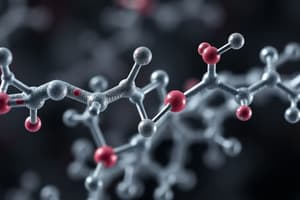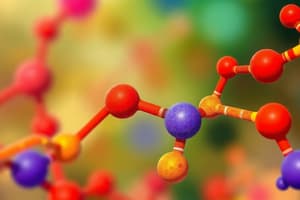Podcast
Questions and Answers
What is the effect of a change in physical or chemical conditions on a protein?
What is the effect of a change in physical or chemical conditions on a protein?
- It always improves the protein's structure.
- It enhances the protein's biological activity.
- It may cause the protein to become denatured. (correct)
- It has no effect on the protein at all.
Which statement accurately describes the structure of DNA?
Which statement accurately describes the structure of DNA?
- DNA consists of nucleotides that contain uracil as a base.
- DNA is a single strand with ribose as its sugar.
- DNA is a double helix structure that is complementary and antiparallel. (correct)
- DNA is composed solely of adenine and thymine.
Which components make up a nucleotide in nucleic acids?
Which components make up a nucleotide in nucleic acids?
- One nitrogenous base, one sugar, and one phosphate group. (correct)
- One sugar, one protein, and one phosphate group.
- Two nitrogenous bases, one sugar, and one phosphate group.
- One nitrogenous base, one sugar, and one protein.
What distinguishes RNA from DNA in terms of structure?
What distinguishes RNA from DNA in terms of structure?
Which of the following nitrogenous bases is found in RNA but not in DNA?
Which of the following nitrogenous bases is found in RNA but not in DNA?
Which type of fatty acids must be supplied in the human diet due to the body's inability to synthesize them?
Which type of fatty acids must be supplied in the human diet due to the body's inability to synthesize them?
What is the primary function of phospholipids in biological membranes?
What is the primary function of phospholipids in biological membranes?
Which component is commonly found in animal cell membranes and serves as a precursor for steroid synthesis?
Which component is commonly found in animal cell membranes and serves as a precursor for steroid synthesis?
What is the monomer that comprises proteins?
What is the monomer that comprises proteins?
Which level of protein structure is characterized by a typical chain of amino acids linked by peptide bonds?
Which level of protein structure is characterized by a typical chain of amino acids linked by peptide bonds?
Which group of amino acids share a common structure that includes an amino group, carboxyl group, and a variable side chain?
Which group of amino acids share a common structure that includes an amino group, carboxyl group, and a variable side chain?
What type of interaction occurs between R groups of amino acids in the tertiary structure of proteins?
What type of interaction occurs between R groups of amino acids in the tertiary structure of proteins?
Which type of steroid serves as signaling molecules that travel throughout the body?
Which type of steroid serves as signaling molecules that travel throughout the body?
What are macromolecules primarily composed of?
What are macromolecules primarily composed of?
Which of the following is NOT a class of macromolecules?
Which of the following is NOT a class of macromolecules?
What is the process of linking monomers together to form polymers called?
What is the process of linking monomers together to form polymers called?
What type of sugar is formed when two monosaccharides are joined together?
What type of sugar is formed when two monosaccharides are joined together?
What occurs during the hydrolysis reaction?
What occurs during the hydrolysis reaction?
Which of the following statements about lipids is true?
Which of the following statements about lipids is true?
Which type of lipid is primarily involved in energy storage?
Which type of lipid is primarily involved in energy storage?
During digestion, what role does water play?
During digestion, what role does water play?
What characteristic do fats have that affects their solubility in water?
What characteristic do fats have that affects their solubility in water?
Which of the following lipids consists of a glycerol backbone bonded to three fatty acids?
Which of the following lipids consists of a glycerol backbone bonded to three fatty acids?
What are the building blocks of polymers called?
What are the building blocks of polymers called?
Which reaction is used to break down polymers into monomers in the digestive system?
Which reaction is used to break down polymers into monomers in the digestive system?
Which type of fatty acid contains one or more double bonds between carbon atoms?
Which type of fatty acid contains one or more double bonds between carbon atoms?
What type of carbohydrate is primarily found in plants and is known for its structural function?
What type of carbohydrate is primarily found in plants and is known for its structural function?
Which type of bond forms between the hydroxyl and carboxyl groups when fats are created?
Which type of bond forms between the hydroxyl and carboxyl groups when fats are created?
Which of the following statements about saturated fatty acids is true?
Which of the following statements about saturated fatty acids is true?
Flashcards are hidden until you start studying
Study Notes
Macromolecules
- Macromolecules are large molecules composed of thousands of covalently bonded atoms.
- The four main classes are carbohydrates, proteins, nucleic acids, and lipids.
- Polymers are long molecules consisting of many similar building blocks linked by covalent bonds.
- Monomers are the repeating units that serve as the building blocks of polymers.
Making and Breaking Polymers
- Dehydration reaction: Two monomers are covalently bonded together by removing water.
- Hydrolysis reaction: Polymers are disassembled (broken down) into monomers using water.
- Digestion is an example of hydrolysis followed by dehydration reactions.
Carbohydrates
- Carbohydrates contain a carbonyl group (C=O) and multiple hydroxyl groups (─OH).
- There are three types of carbohydrates: monosaccharides (simple sugars), disaccharides (double sugars), and polysaccharides (complex sugars).
- Examples of polysaccharides include starch, cellulose (plants) and glycogen (animals).
Lipids
- Lipids are not polymers.
- They are hydrophobic due to their nonpolar covalent bonds.
- Lipids consist mostly of hydrocarbon regions.
- There are three main types of lipids: fats, phospholipids, and steroids.
Fats
- Fats are composed of glycerol and fatty acids joined by ester linkages.
- A fat molecule with three fatty acids is called a triacylglycerol or triglyceride.
- Fats are the primary form of energy storage in organisms.
Types of Fats
- Saturated fatty acids have only single bonds between carbon atoms and are solid at room temperature (e.g., butter, beef fat).
- Unsaturated fatty acids have one or more double bonds between carbon atoms and are liquid at room temperature (e.g., olive oil, linseed oil).
- Some unsaturated fatty acids are essential and must be obtained from the diet (e.g., omega-3 fatty acids).
Phospholipids
- Phospholipids consist of a phosphate group, two fatty acids, and glycerol.
- They form the lipid bilayer of cell membranes.
Steroids
- Steroids are composed of four fused rings with attached chemical groups.
- Examples of steroids include sex hormones and cholesterol.
- Cholesterol is a common component of animal cell membranes and acts as a precursor for the synthesis of other steroids.
Proteins
- Proteins are polymers composed of amino acids.
- There are 20 different types of amino acids.
- Proteins have many functions, including speeding up chemical reactions, defense, storage, transport, cellular communication, movement, and structural support.
Amino Acid Structure
- All amino acids share a common structure with an alpha (α) carbon attached to an amino group (H-N-H), a carboxyl group (O=C-OH), a hydrogen atom, and a variable R side chain.
- The R side chain determines the properties of the amino acid.
Levels of Protein Structure
- Primary structure: The linear sequence of amino acids linked by peptide bonds.
- Secondary structure: Hydrogen bonds form between adjacent amino acids in the polypeptide backbone, resulting in alpha helices or beta sheets.
- Tertiary structure: Interactions between R groups of amino acids (e.g., van der Waals interactions, hydrogen bonds, ionic bonds, disulfide bridges) cause the polypeptide to fold into a specific 3-dimensional shape
- Quaternary structure: Aggregation of two or more polypeptide chains to form a biologically functional protein.
Protein Structure and Function
- Protein structure is influenced by environmental factors such as pH, salt concentration, and temperature.
- Protein function depends on its structure.
- Denaturation is the disruption of a protein's 3D structure, leading to loss of function.
Nucleic Acids
- Nucleic acids are polymers composed of monomers called nucleotides.
- Each nucleotide consists of a phosphate group, a sugar (pentose), and a nitrogenous base.
- The two main types of nucleic acids are DNA and RNA.
DNA (Deoxyribonucleic Acid)
- DNA is a double-stranded molecule (double helix) with complementary base pairing (A-T, C-G).
- The two strands are antiparallel (running in opposite directions).
- DNA serves as the genetic blueprint for organisms, containing the instructions for building and maintaining life.
- The sugar in DNA nucleotides is deoxyribose.
- The nitrogenous bases in DNA are adenine (A), thymine (T), cytosine (C), and guanine (G).
RNA (Ribonucleic Acid)
- RNA is a single-stranded molecule.
- The sugar in RNA nucleotides is ribose.
- The nitrogenous bases in RNA are adenine (A), uracil (U), cytosine (C), and guanine (G).
- RNA plays a vital role in protein synthesis.
DNA and RNA Code
- Both DNA and RNA contain genetic code that specifies the sequence of amino acids in proteins.
Studying That Suits You
Use AI to generate personalized quizzes and flashcards to suit your learning preferences.




